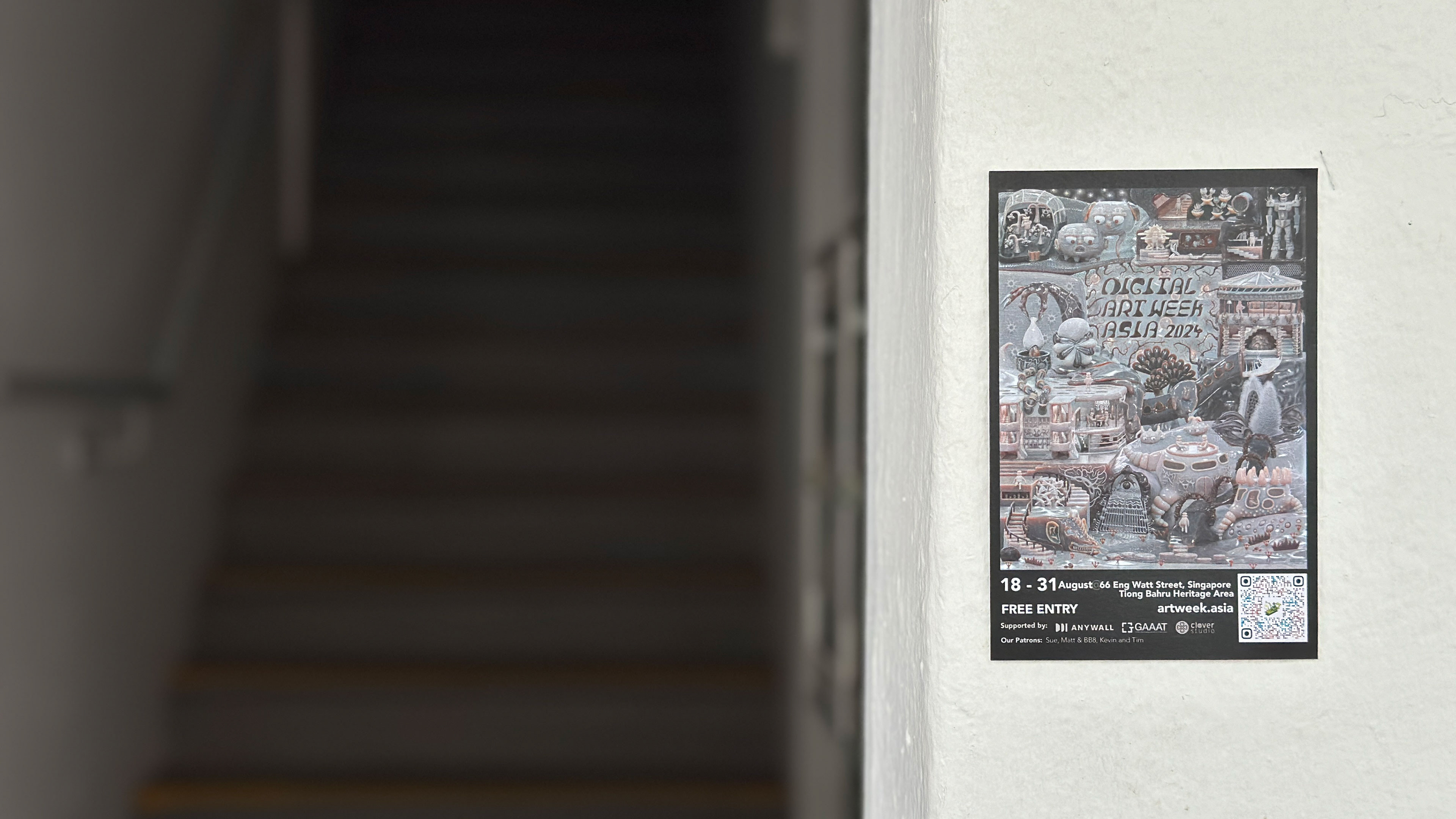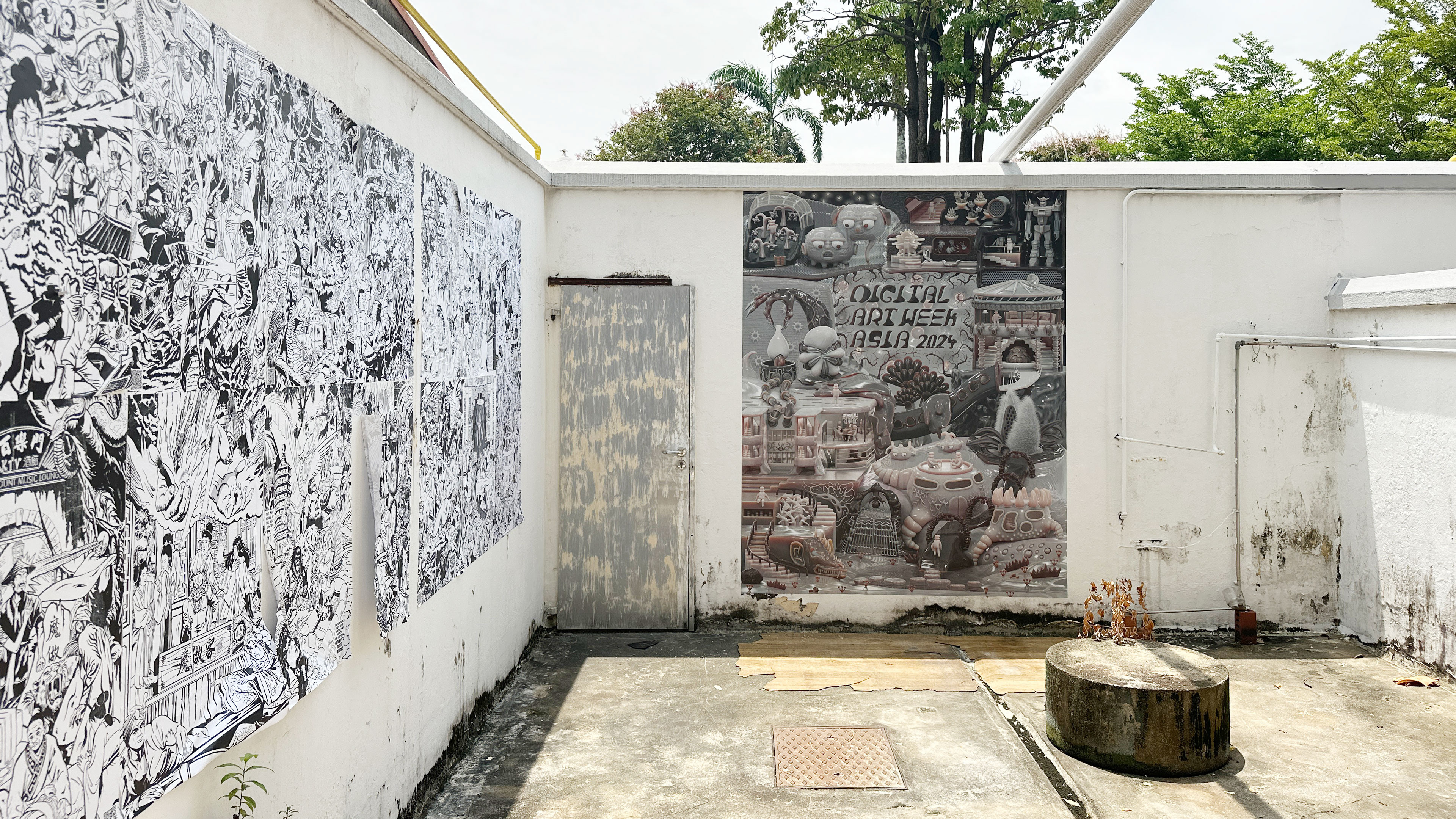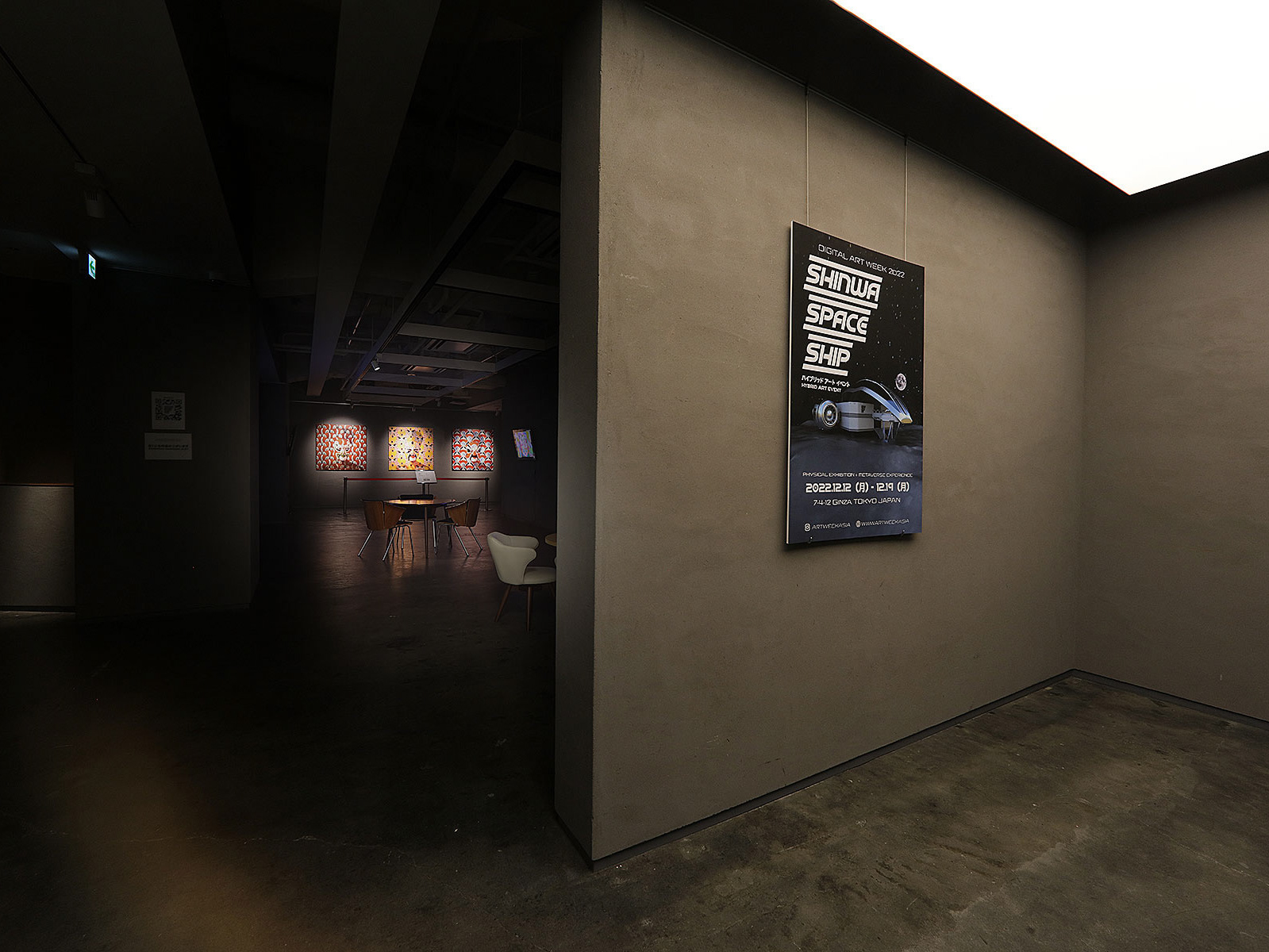「EXHIBITION PHOTOS」

DAWA 2024 logo with Yoichiro Kawaguchi's Koinobori (carp streamers) ©河口 洋一郎

DAWA 2024 postcard with artwork by Tomoro Kinoshita

Entrance to DAWA 2024 Singapore pop-up edition

Presentation of Yoichiro Kawaguchi's AI generated works ©河口 洋一郎

Juxtaposition of high technology inside a private residence in Tiong Bahru

Yoichiro Kawaguchi's work welcome visitors ©河口 洋一郎

Yoichiro Kawaguchi's presentation of digital and hand drawn works ©河口 洋一郎

Yoichiro Kawaguchi's historic work displayed via CRT monitor ©河口 洋一郎

MOJOKO's work of the historic Tiong Bahru district hangs above the stairwell

Masato Inagaki's generative edo period work shown alongside EXCALIBUR's works

EXCALIBUR'S Ukiyo-e works

EXCALIBUR's animated digital work

View from the inner compound out to the courtyard

"Self-Confessed-Critic" by Nozomu Kubota and Kensho Tambara

MOJOKO's animated digital works

DAWA 2024 poster by Tomoro Kinoshita with MOJOKO"s wheatpasted wall art (left)

Yoichiro Kawaguchi's lenticular work last shown at the 46th Venice Biennale in 1995 ©河口 洋一郎

Visitor admiring DAWA 2024 key visual design by Tomoro Kinoshita
↑ Photos from the exhibition
(Click to enlarge)
(Click to enlarge)
Featuring Artists:
EXCALIBUR (JAPAN) • MASATO INAGAKI (JAPAN) •MOJOKO (SINGAPORE) •NOZOMU KUBOTA + KENSHO TAMBARA (JAPAN) • TOMORO KINOSHITA (JAPAN) • YOICHIRO KAWAGUCHI (JAPAN)
Curated by: Warren Wee
Curated by: Warren Wee
「ABOUT」
In 2024, for the first time, Digital Art Week Asia will present a pop-up edition in Singapore after three editions in Tokyo Japan.
The venue is a conserved private residence in Singapore's oldest Art Deco-inspired heritage housing districts, Tiong Bahru.
Situated on the ground level along Eng Watt Street, the interior retains its original 1930s condition, a rarity in modern Singapore.
Post-exhibition, the venue would undergo renovations and be transformed into a modern home, forever closed to the public.
This is a unique opportunity for visitors to experience Singapore in its early days and be immersed in the curated artworks.
The event is produced and curated by Warren Wee with generous support.
「EVENT POSTER」
Event posters available for collection as an NFT (Edition of 888)
COLLECT HERE
「CURATORIAL STATEMENT」
物の哀れ
"Mono no aware"
The Singapore pop-up edition is unique as it is staged in a private residence from the 1930s just before its scheduled renovation, forever erasing all trace of its previous occupant. There is an intimacy and compartmentalisation of the show into three separate rooms due to the layout of the property. In the entrance room, a survey of early black and white 1970s works by the highly accomplished Japanese Computer Graphics pioneer Professor Kawaguchi Yoichiro are juxtaposed against his colour works from the 1990s where he employs mathematics and technology to interpret the fragility and temporality of life. Holding a singular aesthetic axiom has not stopped Kawaguchi from developing works that challenges his conviction, with his most recent works developed via Artificial Intelligence prompts. In the adjoining room, rare works on paper reflects on his thought process and exploration into the most primitive forms of life, painstakingly reimagined by hand with incredible detail and tonality.
The final room before the outdoor courtyard is themed "Edo" and is basked in a warm green glow from the original vintage stained glass. Depicting scenes from Hiroshige Utagawa's "One hundred famous views of Edo", traditional Ukiyo-e (Japanese woodblock prints) are reimagined digitally by Japanese pixel art duo, EXCALIBUR. Shown alongside in the same room, Inagaki Masato's real-time generative artwork of daily life during the Edo period exemplifies his technical finesse and computer gaming background to compose a realistic narrative of emaki ("picture scrolls") set against traditional Japanese paper - a whimsical piece that is ever evolving and captures the bittersweet awareness of the impermanence and transient nature of life.
「FEATURED ARTISTS」
YOICHIRO KAWAGUCHI (b. 1952) is a Japanese CG (Computer Graphics) pioneer, Professor Emeritus at the University of Tokyo and Museum Director at Kirishima Open-Air Museum in Kagoshima Japan. He rose to international prominence in 1982 when he first presented “Growth Model” in the international conference SIGGRAPH. His work has a faithful following and in 2023, he was awarded Person of Cultural Merit by Japan, the country's top honour in the arts. He was the only CG artist to receive this award in the Media Arts Division. Kawaguchi has exhibited widely both within Japan and abroad, including at the 1995 Venice Biennale, MoCA Taipei and Arts Electronica. A rare selection of his hand drawn works on paper, and early historical black and white generative geometrical CG works from 1975 would be shown for the first time in Singapore.
EXCALIBUR are contemporary artists based in Tokyo and Kyoto, Japan. With the theme of real and virtual or its overlap called “Street, Ethernet, Field”, they create art that transforms into social records, by alternating personal memories with stories and myths. Aside from their pixel renditions of Japanese woodblock prints, the artists would be showing "The Well Cradle" and both animated and paper work of "Wonderful Mirror of Japanese Soul, Shibuya" referencing Shibuya in Tokyo as a video game stage, this work depicts Halloween in the West, and "Hyakki Yagyō" (Night Parade of One Hundred Demons, an idiom in Japanese folklore) in the East. Truly a work where the real and virtual coexist.
MASATO INAGAKI (b.1969) studied sculpture and contemporary art in college and has over twenty years of experience in video game production, he saw the opportunity to bridge the gap between art and technology in his art practice where the use of computers generate real-time works which constantly changes. Inagaki also believes that technology would be the new colouring material, in a world where new advancements have changed the landscape and have merged humans with technology to create a matrix style environment.
NOZOMU KUBOTA is an inventor, manager, YouTuber with over 300,000 followers, AI developer (with 20 patents in Japan, US, China and Hong Kong) and contemporary artist since 2022. Together with
KENSHO TAMBARA (b.1992), an artist, highly accomplished curator and Harvard art history graduate, they are presenting "Self-Confessed-Critic" in Singapore. This piece utilises an AI model which learns the exaggerated and redundant words of criticism that appears throughout exhibitions held by GAGOSIAN Gallery. Watch this piece continuously output critical expressions using a pen plotter, occasionally outputting neologism words that do not exist and revealing the inherent futility of art criticism by highlighting its often obscure nature. In an era where texts laden with jargon and abstract terminology qualify as art criticism, this work questions AI's true understanding of using words in context.
Digital Art Week Asia 2024 event poster inspired by Tiong Bahru would also be created by artist TOMORO KINOSHITA, with wheat-pasted wall art by MOJOKO.
#digitalartweekasia2024
IMDA Arts Entertainment Licence AEL/2408/0023
In 2024, for the first time, Digital Art Week Asia will present a pop-up edition in Singapore after three editions in Tokyo Japan.
The venue is a conserved private residence in Singapore's oldest Art Deco-inspired heritage housing districts, Tiong Bahru.
Situated on the ground level along Eng Watt Street, the interior retains its original 1930s condition, a rarity in modern Singapore.
Post-exhibition, the venue would undergo renovations and be transformed into a modern home, forever closed to the public.
This is a unique opportunity for visitors to experience Singapore in its early days and be immersed in the curated artworks.
The event is produced and curated by Warren Wee with generous support.
「EVENT POSTER」
Event posters available for collection as an NFT (Edition of 888)
COLLECT HERE
「CURATORIAL STATEMENT」
物の哀れ
"Mono no aware"
The Singapore pop-up edition is unique as it is staged in a private residence from the 1930s just before its scheduled renovation, forever erasing all trace of its previous occupant. There is an intimacy and compartmentalisation of the show into three separate rooms due to the layout of the property. In the entrance room, a survey of early black and white 1970s works by the highly accomplished Japanese Computer Graphics pioneer Professor Kawaguchi Yoichiro are juxtaposed against his colour works from the 1990s where he employs mathematics and technology to interpret the fragility and temporality of life. Holding a singular aesthetic axiom has not stopped Kawaguchi from developing works that challenges his conviction, with his most recent works developed via Artificial Intelligence prompts. In the adjoining room, rare works on paper reflects on his thought process and exploration into the most primitive forms of life, painstakingly reimagined by hand with incredible detail and tonality.
The final room before the outdoor courtyard is themed "Edo" and is basked in a warm green glow from the original vintage stained glass. Depicting scenes from Hiroshige Utagawa's "One hundred famous views of Edo", traditional Ukiyo-e (Japanese woodblock prints) are reimagined digitally by Japanese pixel art duo, EXCALIBUR. Shown alongside in the same room, Inagaki Masato's real-time generative artwork of daily life during the Edo period exemplifies his technical finesse and computer gaming background to compose a realistic narrative of emaki ("picture scrolls") set against traditional Japanese paper - a whimsical piece that is ever evolving and captures the bittersweet awareness of the impermanence and transient nature of life.
「FEATURED ARTISTS」
YOICHIRO KAWAGUCHI (b. 1952) is a Japanese CG (Computer Graphics) pioneer, Professor Emeritus at the University of Tokyo and Museum Director at Kirishima Open-Air Museum in Kagoshima Japan. He rose to international prominence in 1982 when he first presented “Growth Model” in the international conference SIGGRAPH. His work has a faithful following and in 2023, he was awarded Person of Cultural Merit by Japan, the country's top honour in the arts. He was the only CG artist to receive this award in the Media Arts Division. Kawaguchi has exhibited widely both within Japan and abroad, including at the 1995 Venice Biennale, MoCA Taipei and Arts Electronica. A rare selection of his hand drawn works on paper, and early historical black and white generative geometrical CG works from 1975 would be shown for the first time in Singapore.
EXCALIBUR are contemporary artists based in Tokyo and Kyoto, Japan. With the theme of real and virtual or its overlap called “Street, Ethernet, Field”, they create art that transforms into social records, by alternating personal memories with stories and myths. Aside from their pixel renditions of Japanese woodblock prints, the artists would be showing "The Well Cradle" and both animated and paper work of "Wonderful Mirror of Japanese Soul, Shibuya" referencing Shibuya in Tokyo as a video game stage, this work depicts Halloween in the West, and "Hyakki Yagyō" (Night Parade of One Hundred Demons, an idiom in Japanese folklore) in the East. Truly a work where the real and virtual coexist.
MASATO INAGAKI (b.1969) studied sculpture and contemporary art in college and has over twenty years of experience in video game production, he saw the opportunity to bridge the gap between art and technology in his art practice where the use of computers generate real-time works which constantly changes. Inagaki also believes that technology would be the new colouring material, in a world where new advancements have changed the landscape and have merged humans with technology to create a matrix style environment.
NOZOMU KUBOTA is an inventor, manager, YouTuber with over 300,000 followers, AI developer (with 20 patents in Japan, US, China and Hong Kong) and contemporary artist since 2022. Together with
KENSHO TAMBARA (b.1992), an artist, highly accomplished curator and Harvard art history graduate, they are presenting "Self-Confessed-Critic" in Singapore. This piece utilises an AI model which learns the exaggerated and redundant words of criticism that appears throughout exhibitions held by GAGOSIAN Gallery. Watch this piece continuously output critical expressions using a pen plotter, occasionally outputting neologism words that do not exist and revealing the inherent futility of art criticism by highlighting its often obscure nature. In an era where texts laden with jargon and abstract terminology qualify as art criticism, this work questions AI's true understanding of using words in context.
Digital Art Week Asia 2024 event poster inspired by Tiong Bahru would also be created by artist TOMORO KINOSHITA, with wheat-pasted wall art by MOJOKO.
#digitalartweekasia2024
IMDA Arts Entertainment Licence AEL/2408/0023
↑ Digital Art Week Asia 2024 Vernissage
17 August 2024

Artist Nozomu Kubota introduces his artwork "Self-Confessed-Critic"

Artist Yoichiro Kawaguchi introducing his physical and digital works to guests

Artist Yoichiro Kawaguchi signs posters for guests

Entrance of the exhibition

Artist Boedi Widjaja , Curator Ute Meta Bauer, Audrey Koh and DAWA Curator Warren Wee

Japan Creative Centre (JCC) Director Akiko Kawabe with Artist Yoichiro Kawaguchi

Television legend Robert Chua and family with Curator Warren Wee pose outside the facade of the historic Tiong Bahru venue
↑ Photos from the Vernissage
(Click to enlarge)
(Click to enlarge)
「MAP」










